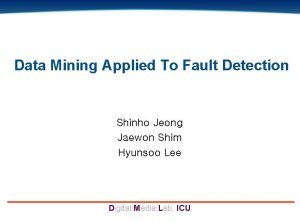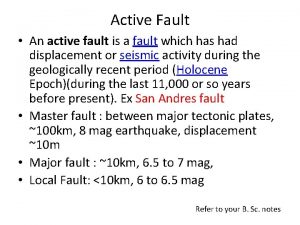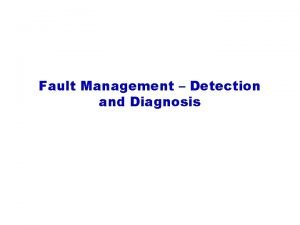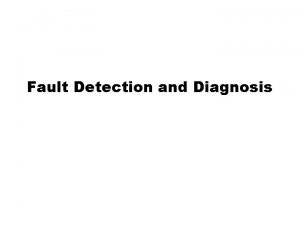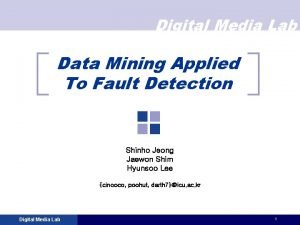Data Mining Applied To Fault Detection Shinho Jeong















- Slides: 15

Data Mining Applied To Fault Detection Shinho Jeong Jaewon Shim Hyunsoo Lee Digital Media Lab, ICU

Abstract q Aims of work Ø Neural Network Implementation of the Non-linear PCA model using Principal Curve algorithm to increase both rapidity & accuracy of fault detection. q Data mining? Ø Extracting useful information from raw data using statistical methods and/or AI techniques. q Characteristics Ø Maximum use of data available. Ø Rigorous theoretical knowledge not required. Ø Efficient for a system with deviation between actual process and first principal based model. q Application Ø Process monitoring Ü Fault detection/diagnosis/isolation Ø Process estimation Ü Soft sensor 2 DML, ICU

Fault Detection(1) Fault introduction 3 DML, ICU

Fault Detection(2) q Major concerns Ø Rapidity Ü Ability to detect fault situation at an earlier stage of fault introduction. Ø Accuracy Ü Ability to distinguish fault situation from possible process variations. q Trade-off problem Ø Solve through Ü Frequent acquisition of process data. Ü Derivation of efficient process model through data analysis using Data mining methodologies. 4 DML, ICU

Fault Detection(3) q Inherent problems ① Multi-colinearity problem Ü Due to high correlation among variables. þ Likely to cause redundancy problem. þ Derivation of new uncorrelated feature variables required. ② Dimensionality problem Ü Due to more variables than observations. þ Likely to cause over-fitting problem in model-building phase. þ Dimensional reduction required. ③ Non-linearity problem Ü Due to non-linear relation among variables. þ Pre-determination of degree of non-linearity required. þ Application of non-linear model required. ④ Process dynamics problem Ü Due to change of operating conditions with time. þ Likely to cause change of correlation structure among variables. 5 DML, ICU

Fault Detection(4) q Statistical data analysis Ø Uni-variate SPC Ü Conventional Shewart, CUSUM, EWMA, etc. Ü Limitations þ Perform monitoring for each process variable. Ä Inefficient for multi-variate system. þ More concerned with how variables co-vary. Ä Need for multi-variate data analysis Ø Multi-variate SPC Ü PCA þ Most popular multi-variate data analysis method. þ Basis for regression modesl(PLS, PCR, etc). 6 DML, ICU

Linear PCA(1) q Features Ø Creation of… Ü Fewer => solve ‘Dimensionality problem‘ & Ü Orthogonal => solve ‘Multi-colinearity problem‘ new feature variables(Principal components) through linear combination of original variables. Ø Perform Noise reduction additionally. Ø Basis for PCR, PLS. q Limitation Ø Linear model => inefficient for nonlinear process. 7 DML, ICU

Linear PCA(2) q Theory Encoding mapping Decoding mapping 8 DML, ICU

Linear PCA(3) q ERM inductive principle q Limitation q Alternatives Ø Extension of linear functions to non-linear ones using… Ü Neural networks. Ü Statistical method. 9 DML, ICU

Kramer’s Non-linear PCA q Limitations Ø Difficult to train the networks with 3 hidden layers. Ø Difficult to determine the optimal # of hidden nodes. Ø Difficult to interpret the meaning of the bottle-neck layer. 10 DML, ICU

Non-linear PCA(1) q Principal curve(Hastie et al. 1989) Ø Statistical, Non-linear generalization of the first linear Principal component. q Self-consistency principle ① Projection step(Encoding) ② Conditional averaging(Decoding) 11 DML, ICU

Non-linear PCA(2) q Limitations Ø Finiteness of data. Ø Unknown density distribution. Ø No priori information about data. q Additional consideration ② Conditional averaging => Locally weighted regression, Kernel regression Ø Increasing flexibility(Span decreasing) Ü Span : fraction of data considered to be in the neighborhood. ~ smoothness of fit ~ generalization capacity 12 DML, ICU

Proposed Approach(1) q Creation of Non-linear principal scores 13 DML, ICU

Proposed Approach(2) q Implementation of Auto-associative N. N. 14 DML, ICU

Conclusion q Future works Ø Implementation of the proposed Neural Network structure. Ø Application for a case study 15 DML, ICU
 Shinho jeong
Shinho jeong Mining complex types of data
Mining complex types of data Mining multimedia databases
Mining multimedia databases Strip mining vs open pit mining
Strip mining vs open pit mining Chapter 13 mineral resources and mining worksheet answers
Chapter 13 mineral resources and mining worksheet answers Difference between strip mining and open pit mining
Difference between strip mining and open pit mining Difference between text mining and web mining
Difference between text mining and web mining Data reduction in data mining
Data reduction in data mining What is data mining and data warehousing
What is data mining and data warehousing What is missing data in data mining
What is missing data in data mining Concept hierarchy generation for nominal data
Concept hierarchy generation for nominal data Data reduction in data mining
Data reduction in data mining Data reduction in data mining
Data reduction in data mining Data cube technology in data mining
Data cube technology in data mining Data reduction in data mining
Data reduction in data mining Perbedaan data warehouse dan data mining
Perbedaan data warehouse dan data mining
